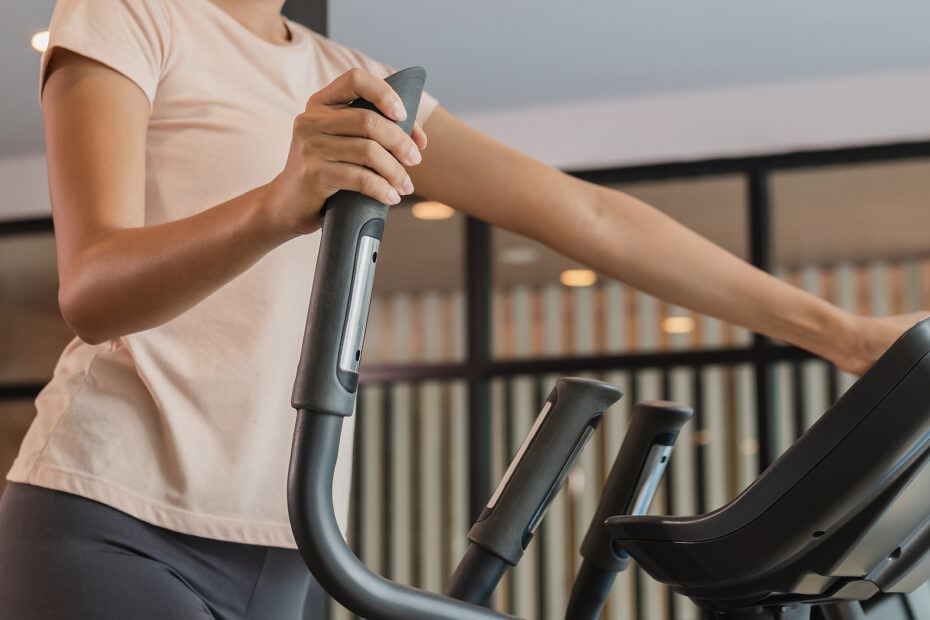Elliptical machines and stationary bikes can both offer low-impact cardio and strength benefits for seniors looking to stay active.
But they go about it in very different ways.
The most notable difference is that an elliptical machine requires you stand during the entirety of your workout, while a stationary bike allows you to remain seated throughout.
But there are a few other key differences worth knowing about when trying to choose between these exercise machines as well.
In this guide, we’ll go over all the advantages each fitness machine offers, as well the considerations seniors should make when deciding which machine makes more sense for their home.
After reading, you’ll know whether you should opt for an elliptical machine or stationary bike to meet your goals.
Why Low-Impact Exercise Matters for Seniors
Low-impact exercise is an ideal way for seniors to stay active without putting excessive strain on the joints.
Gentle, prolonged movement is actually really good for arthritic and achy joints because it helps lubricate the joint surfaces, reducing stiffness.
Regular exercise also helps maintain strength in the muscles around the joints – and being stronger is always a good thing.
And guess what, elliptical machines and stationary bikes are both considered low-impact, making them popular choices for older adults.
Regular use of either machine can help improve cardiovascular health, maintain muscle tone, and enhance flexibility, all while reducing the risk of injury compared to higher-impact workouts.
That said, they each have their own advantages and disadvantages.
Let’s start with the ellipticals.
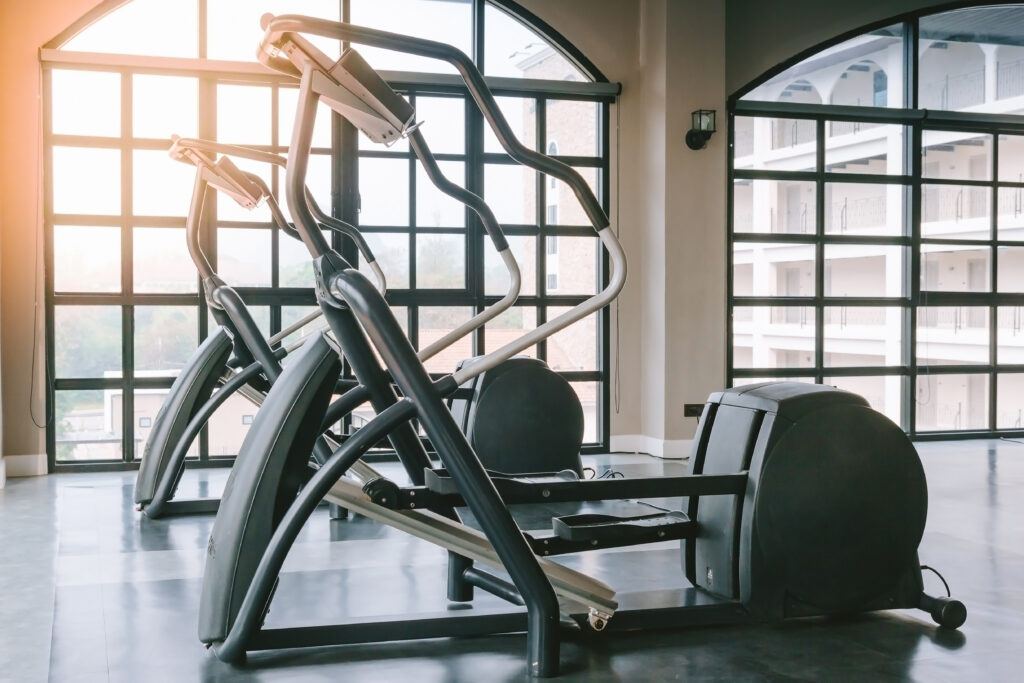
Benefits of Elliptical Machines for Seniors
Just to make sure we’re all on the same page – an elliptical is an exercise machine that involves standing on a set of pedals and holding onto a pair of moving (or stationary) handles.
The pedaling motion of an elliptical usually follows an oblong, circular pattern (aka, “elliptical”), while the pedals simply go back and forth.
Elliptical machines are a great option for seniors who want a total-body workout, while being gentle on the joints.
Here’s a look at their specific benefits:
Full-Body Workout
Ellipticals engage both the upper and lower body by allowing users to hold handlebars and move their legs in a gliding motion.
This smooth, continuous movement is easy on the joints, reducing the risk of strain, but it’s still a potent way to get your heart rate up and work the muscles in your arms and legs.
And since you have to maintain your balance while pedaling, you get to work your core muscles as well.
Gentle on the Joints
Your feet never leave the pedals on an elliptical, so there’s very little impact going through your knees and hips while using these machines.
You do have to stand on an elliptical (it’s a weight bearing exercise), so I would consider an elliptical to be a little more impactful than a stationary bike (which is non-weight bearing).
But even seniors with mild to moderate arthritis can usually use an elliptical machine comfortably.
Improved Balance and Coordination
The motion of an elliptical requires a certain level of balance, which can help improve stability.
And seniors that are capable of exercising on an elliptical without holding on, can challenge their balance and stability even more.
This benefit is essential for seniors, as enhanced balance can help lower fall risk.
Adjustable Resistance and Incline
Elliptical machines offer adjustable resistance, which allows users to control the workout’s intensity.
And many ellipticals also offer Incline adjustments, that give the user a lot more workout options.
You can adjust the incline to mimic stair climbing or walking uphill, providing a more strenuous lower-body workout if desired.
Drawbacks of Elliptical Machines
Elliptical machines can offer a great workout, but that doesn’t mean they’re for everyone.
Like everything in life, they have their disadvantages as well:
Higher Learning Curve
Ellipticals aren’t difficult to use, but the coordination required to operate an elliptical can be challenging for some seniors.
Elliptical machines can take a little getting used to, making them a little harder to use than stationary bikes.
More Demanding on Balance
As mentioned above, it takes a little more mobility and balance to get on/off an elliptical and use one safely.
Seniors with balance issues may feel less stable on an elliptical machine and may have trouble accessing it in the first place.
Seniors with a history of falls or significant mobility deficits will likely fine a stationary bike easier to use.
Take Up More Space
Ellipticals come in various sizes, but generally speaking, elliptical machines tend to take up more floor space than your average stationary bike.
Specifically, most home ellipticals take up a foot print of roughly 2′ x 6-7′.
Plus you need a little wiggle room on each side to allow safe operation and to ensure enough room to get on/off the machine comfortably.
Seniors with smaller homes may not have the space necessary for an elliptical.
More Expensive
Like any other fitness machine, ellipticals come in various price ranges, but generally speaking, ellipticals tend to be a little more expensive than stationary bikes.
Most home ellipticals cost $600+, which could make them too expensive for seniors working with smaller budgets.
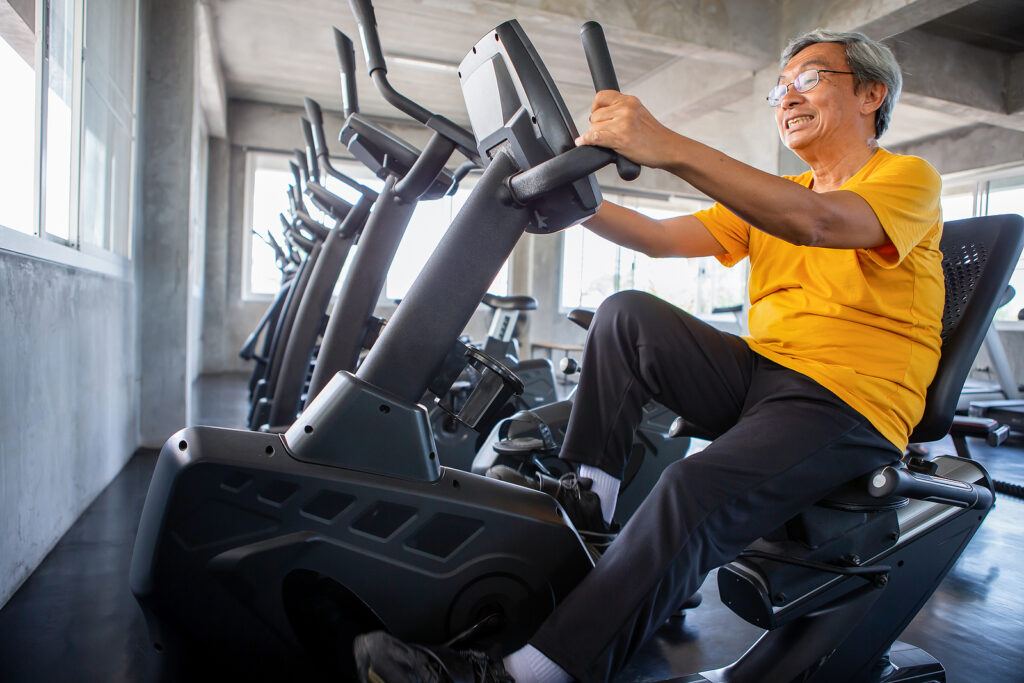
Benefits of Stationary Bikes for Seniors
Stationary bikes come in various styles, but the most common include indoor cycles, upright bikes, and recumbent bikes.
Stationary bikes, especially recumbent models, are often more accessible for seniors, offering a highly controlled environment for safe exercise.
Benefits include:
Joint-Friendly Exercise
Stationary bikes, especially recumbent bikes, are very gentle on the joints.
The seated position and circular pedal motion reduce impact on knees, hips, and ankles, making stationary bikes a gentle option for joint health.
And since you get to sit comfortably throughout the workout, stationary bikes are considered even lower-impact than ellipticals.
Seniors looking for the lowest-impact option will likely prefer a recumbent bike (or a recumbent cross-trainer).
Easy to Use
Unlike elliptical machines, which can be a little more challenging to get on and start using, stationary bikes are very easy to use.
Stationary bikes have a simple design and a straightforward operation that is ideal for seniors, even those new to exercise.
And the fact that you simply have to sit down and get your feet on the pedals makes them easier to access for seniors with mobility and balance deficits.
Options for Different Needs
There are three main types of stationary bikes for seniors: upright bikes, recumbent bikes, and indoor cycles.
Recumbent bikes are particularly popular because they provide back support and a reclined seating position, reducing pressure on the lower back.
But seniors looking for higher-intensity workouts or more realistic biking experiences can opt for indoor cycles or upright bikes.
Adjustable Resistance
Like ellipticals, stationary bikes also offer resistance adjustments, so users can increase or decrease the intensity of their workouts as they see fit.
And even though recumbent bikes offer a more comfortable experience, it doesn’t mean seniors still can’t crank that resistance up and get a great workout in if they want to.
Take Up Less Space
In general, stationary bikes take up a lot less floor space than an elliptical machine.
Even the largest exercise bikes (recumbents) take up less room than an average-sized elliptical.
And upright bikes and indoor cycles take up even less room, making them ideal for homes with limited floor space.
For the sake of comparison, your average recumbent bike takes up a footprint of roughly 2.5′ x 5′.
Less Expensive
Again, stationary bikes come in all kinds of price ranges too (and there are some very expensive exercise bikes out there), but generally speaking, exercise bikes are less expensive than ellipticals.
There are some solid stationary bikes out there that cost a few hundred bucks.
This may make a stationary bike a better option for homes dealing with smaller budgets.
Drawbacks of Stationary Bikes
Limited Upper Body Engagement
Unlike elliptical machines, most stationary bikes don’t come with any moving handles for your arms.
This is because stationary bikes primarily focus on the lower body, so additional exercises may be needed to work the upper body.
Exercise bikes also don’t engage your core as much as an elliptical machine does.
Less Weight-Bearing Exercise
While this can be easier on the joints, stationary biking doesn’t support bone density like elliptical use does.
This also means exercising on a stationary bike won’t burn quite as many calories or get your heart rate up quite as high as exercising on an elliptical would (assuming comparable resistance settings).
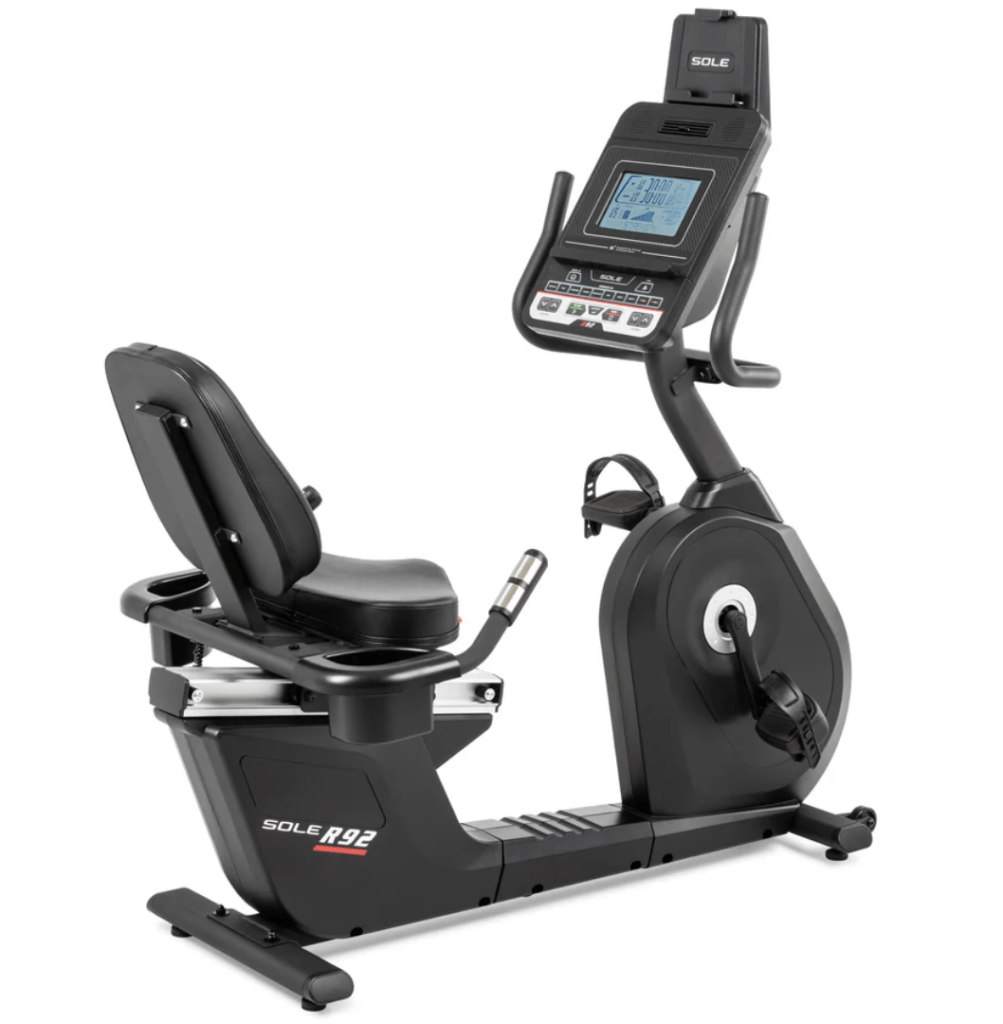
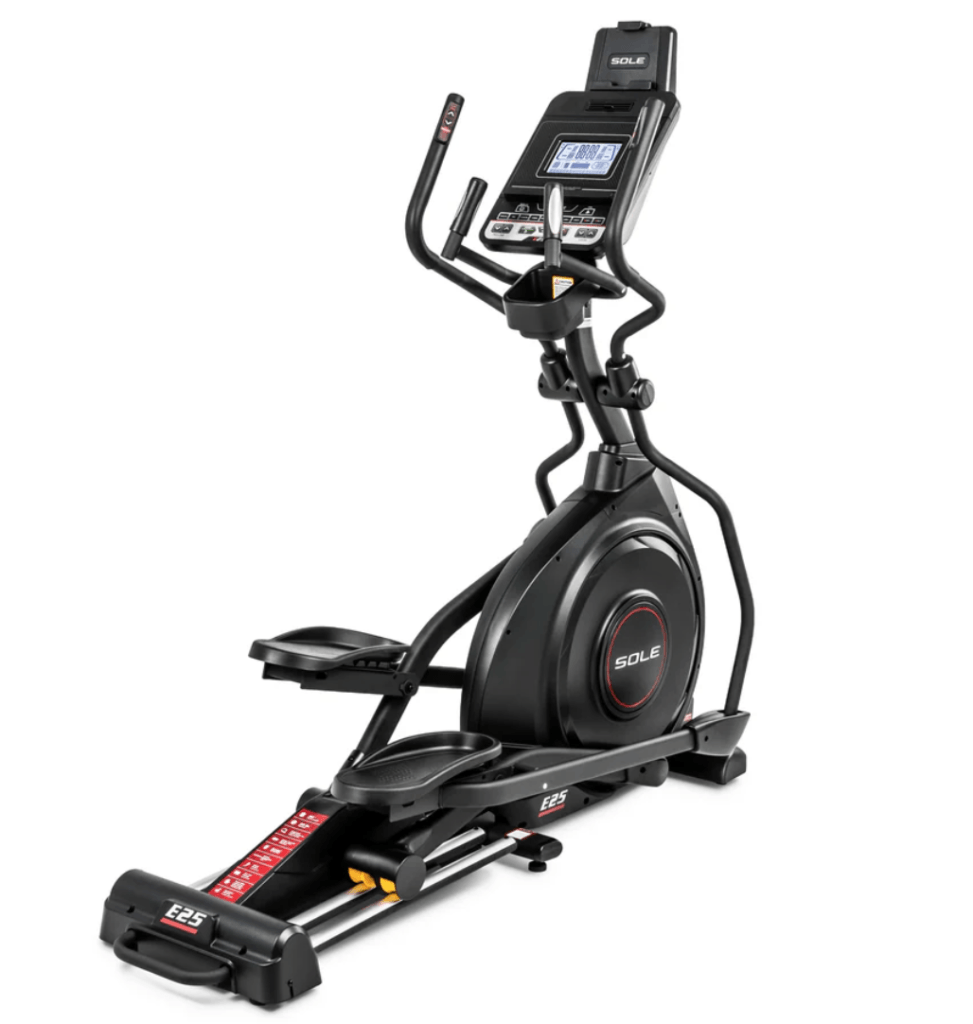
| Feature | Elliptical Machine | Stationary Bike |
|---|---|---|
| Impact Level | Low, but weight-bearing | Very low, non-weight-bearing |
| Muscle Engagement | Full-body | Primarily lower body |
| Ease of Use | Higher learning curve | Simple, easy for beginners |
| Balance Support | Requires decent balance | Requires less balance |
| Suitability for Joint Pain | Gentle on joints but requires stability | Excellent for reducing joint strain |
| Bone Health | More beneficial for bone density | Fewer bone health benefits |
Key Considerations When Choosing Between an Elliptical and a Stationary Bike
1. Mobility and Stability Needs
- Elliptical: Great for those who have good balance and want to work on coordination.
- Stationary Bike: Ideal for those who need extra stability or prefer to exercise in a seated position.
2. Intensity and Exercise Goals
- Elliptical: Allows for full-body engagement, making it suitable for those looking for a more demanding cardiovascular workout.
- Stationary Bike: Provides a comfortable, lower-intensity option for those focused on maintaining mobility and gentle cardio exercise.
3. Space and Convenience
- Elliptical: Requires more room and usually costs more due to its size and added features.
- Stationary Bike: Compact, easy to store, and often more affordable.
4. Health Conditions
- Elliptical: Works well for those with mild to moderate mobility and stability issues, but may be less suitable for those with severe arthritis or balance concerns.
- Stationary Bike: Ideal for those with joint pain or lower back issues due to the recumbent model’s back support and low-impact design.
Which Option is Better for Bone Health?
When it comes to bone health, weight-bearing exercises are beneficial as they encourage bone density maintenance.
Elliptical machines offer this advantage over stationary bikes, which are non-weight-bearing (meaning you’re sitting).
Seniors dealing with osteoporosis or who are simply looking to improve or maintain bone health may benefit more from an elliptical routine.
Which Option is Better for Arthritic Joints?
For seniors with arthritis, the choice between an elliptical machine and a stationary bike is crucial, as each affects the joints differently.
Generally, stationary bikes, especially recumbent models, are considered better for individuals with arthritis.
The seated position and gentle, circular pedaling motion place minimal stress on the hips, knees, and ankles, reducing joint discomfort.
And the back support offered by recumbent bikes also alleviates pressure on the spine, making it a comfortable choice for those with arthritis.
While ellipticals offer a low-impact workout, they may require more balance and stability.
For those with mild arthritis, the smooth, gliding motion of an elliptical can be beneficial, engaging multiple muscle groups without the harsh jolt of running.
However, if balance is a concern or if arthritis symptoms are severe, the stationary bike is usually the safer, more joint-friendly choice.
Ultimately, choosing the best option depends on the severity of arthritis, individual mobility, and comfort level during exercise.
Seniors with arthritis may want to consider starting with a stationary bike and progressing to an elliptical if comfortable.
Safety Considerations for Seniors
- Use Proper Equipment: Ensure handrails (ellipticals) and sturdy grips (stationary bikes) are available.
- Start with Low Resistance: Begin with minimal resistance and gradually increase as comfort grows.
- Practice Correct Posture: Sit upright on a bike or hold handlebars properly on an elliptical for balance and joint support.
- Listen to Your Body: Stop if you feel pain or discomfort, especially if it affects joints or the lower back.
And as always, if you have any doubts about starting a new exercise routine or about what exercises are safe for you, please consult your healthcare provider first.
Safety is always the biggest priority, so again, always consult your family physician before starting any new exercise you aren’t sure about.
Final Thoughts
Well, there ya have it.
Elliptical machines and stationary bikes can both be great options for seniors looking to stay active, but there are quite a few differences between these machines.
Ultimately, the choice between an elliptical and a stationary bike depends on your specific needs, goals, and physical health.
If you want a full-body workout with weight-bearing benefits and have decent balance, an elliptical may be the right choice.
If a seated, low-impact option suits you best, a stationary bike (especially a recumbent bike) will likely make more sense.
Whichever you choose, both machines provide a safe, effective way to support fitness and health as you age.
If you have any questions or comments, feel free to leave ’em below and I’ll get back to you shortly.
